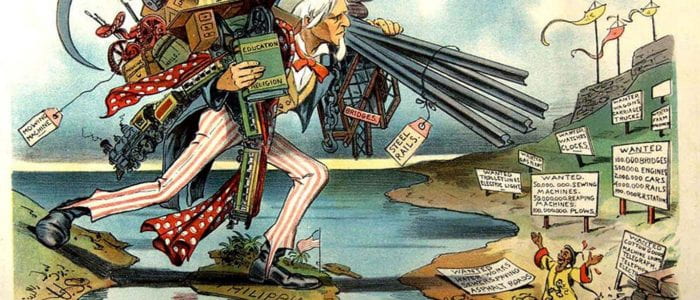Imperialism. The extension of a nation’s power through the forceful acquisition of territories in an attempt to gain political or economic control. We, as citizens of a more developed country, have yet to fully comprehend the implications that the word carries. The United States of America has found success in solidifying its place as a world power through the capturing and exploitation of less developed countries in order to enhance the wealth and prosperity of their own. While imperialism was a widely accepted practice amongst the world powers within the context of many periods in history, the United States of America is lacking in the acceptance of this history through omitting important instances of imperialism, such as the Philippine-American War.
Philippine history is plagued by imperialistic control and the exploitation of its native people. In the late 16th century, the Philippines was colonized by Spain, who wished to spread the beliefs of the Roman Catholic Church. In 1863, public education was dominated by religious influences. Students were taught under clerical instruction, but limited higher education encouraged students fortunate enough, to travel to Europe to continue their education.
Upon their return, the liberal influences of Europe had ignited a desire for reformation amongst the people of the Philippines. Nationalist pride spread throughout the lower cast, encouraging the rise of activists and rebels. Revolts began to break out as Filipinos called for the independence of their people and thus starting the rise of Emilio Aguinaldo.

As leader of the rebel group called the Katipunan, Aguinaldo fought against the Spanish until December 1897, when an agreement ended the Philippine revolution. In return for his exile to Hong Kong, the Spanish promised to bring reformation to the Philippines. The changes were slow to come and by the late 19th century, war had broken out between the Spanish and the United States of America, causing Spanish focus to be drawn away from reform and towards the protection of their territory.
Cuban desire for independence from Spain sparked a national outrage in the United States as Americans witnessed graphic portrayals of Spanish cruelty. As sympathy rose amongst American citizens, the demand for U.S. involvement in Cuba saw an increase in support. The desire for U.S. intervention came to fruition when the USS Maine mysteriously sank in Havana harbor on February 15, 1898. Wild claims by newspaper articles blamed the sinking on the Spanish, calling for revenge and Cuba’s right to independence.

Spain, however, was not prepared to fight a war at such distance. On May 1, 1898, George Dewey led the U.S. Navy to victory in Manila Bay, leading to the occupation of Manila by the United States. The Treaty of Paris was signed on December 10, 1898 relinquishing all control of Cuba, Guam, Puerto Rico, and the Philippines to the United States.
This was not what the Philippine people had been promised. They wanted their independence, not a change in ruler. Emilio Aguinaldo, feeling betrayed, led the revolution against American forces in a war that would last from 1899 – 1902. Failing to find success in conventional warfare methods against well trained and well equipped American troops, Aguinaldo turned to guerilla-style warfare. In an effort to devalue the attempt at independence, the United States saw the bloodshed as a mere insurrection, instead of a revolt against a foreign invader. By the end of the war, 4,200 American and 20,000 Filipino combatants were dead. This is slight in comparison to the death toll of Filipino civilians. 200,000 civilians fell to violence, famine, and disease. It was not until the end of World War II, after the Philippines fell under rule of the Japanese, were they able to gain their independence.
When looking at Texas standards, the acquisition of the Philippines falls to being a supporting factor in the rise of the U.S. as a world power. There is no requirement to explain the effects of imperialistic rule on the country and its people. In fact, students are often not aware of what happens beyond the transfer of colonial power from Spain to the United States. It is as if the Philippine-American War never existed. It is your duty as a historian to discover the truth in the events that took place after the Spanish-American War. Why is the Philippine-American War often ignored when discussing the United States’ role in imperialism? What ideals were in the minds of American leaders that encouraged the torture and ownership of a less developed country and its people? If we were to directly address the United States’ darker history, how would that change the national narrative and citizens’ perspectives of the country?
As you explore this website further, we want you to consider the reasoning behind omitting more violent instances in American history, while analyzing the importance of addressing these events in the classroom.







